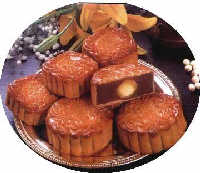 One of the most important traditional Chinese festivals, the Mid-Autumn Festival falls on the 15th day of the eighth lunar month, around the time of the autumn equinox (usually September 22). Many refer to it simply as the "Fifteenth of the Eighth Month." As the full bright moon on that night tends to inspire people's anticipation for a family reunion, it is also called "Festival of Reunion."
One of the most important traditional Chinese festivals, the Mid-Autumn Festival falls on the 15th day of the eighth lunar month, around the time of the autumn equinox (usually September 22). Many refer to it simply as the "Fifteenth of the Eighth Month." As the full bright moon on that night tends to inspire people's anticipation for a family reunion, it is also called "Festival of Reunion."
This day is also considered a harvest festival since farmers have just finished gathering their crops and bringing in fruits from the orchards. Overwhelmed with joy when they have a bumper harvest and quite relaxed after a year of hard work, they feel it is a time for relaxation and celebration.
Food offerings -- including moon cakes, apples, pears, peaches, grapes, pomegranates, watermelons, oranges, and so on -- are placed on an altar set up in the courtyard. Of all these foods, moon cakes and watermelons (cut into the shape of a lotus) are indispensable for the Mid-Autumn Festival. Bathing in the silver moonlight, the families will sit together and take turns to worship the moon, chatting and sharing the moon offerings.
 Origin
Origin
 The Mid-Autumn Festival is a traditional festivity for both the Han and minority nationalities, with a history of more than 2,000 years. In feudal times, Chinese emperors prayed to Heaven for a prosperous year. They chose the morning of the 15th day of the second lunar month to worship the sun and the evening of the 15th day of the eighth lunar month to hold a ceremony in praise of the moon. In the western district of Beijing is Yuetan Park, which originally was the Moon Temple. Every year the emperor would go there to offer a sacrifice to the moon.
The Mid-Autumn Festival is a traditional festivity for both the Han and minority nationalities, with a history of more than 2,000 years. In feudal times, Chinese emperors prayed to Heaven for a prosperous year. They chose the morning of the 15th day of the second lunar month to worship the sun and the evening of the 15th day of the eighth lunar month to hold a ceremony in praise of the moon. In the western district of Beijing is Yuetan Park, which originally was the Moon Temple. Every year the emperor would go there to offer a sacrifice to the moon.
The custom of worshipping the moon (called xi yue in Chinese) can be traced back to as far as the ancient Xia and Shang Dynasties (21-11th century BC). In the Zhou Dynasty(11th century-256BC), people held ceremonies to greet winter and worship the moon whenever the mid-Autumn set in. It became prevalent in the Tang Dynasty(618-907) for the people to enjoy and worship the full moon. During the Southern Song Dynasty(1127-1279), however, people sent round cakes to their relatives as gifts to express their best wishes for a family reunion. When it became dark, they would look up at the full silver moon or go sightseeing by the lakeside to celebrate the festival.
